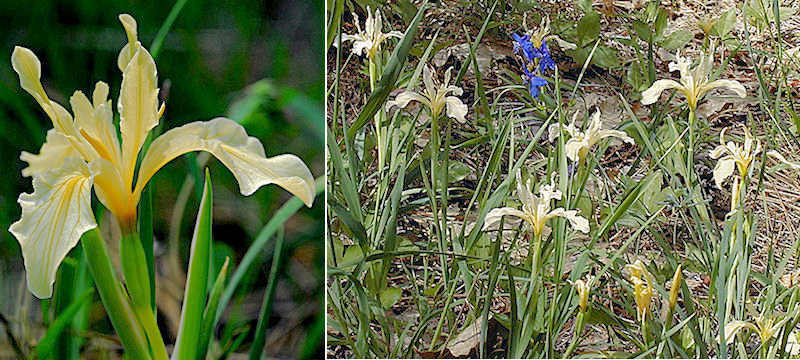Wild PCN iris - short tube group (3 species), spathes spreading:
9. Sierra Iris - Iris hartwegii

(L) near Emigrant Gap, Placer Co. CA. © Michael Graupe; (R) Hwy 20, above Nevada City, CA. Steve Ayala

Range: Western Sierra Nevada Mountains above the foothills, from Plumas Counth at the southern tip of the Cascade Range, south to Kern County; 2,000 to 7,000 feet elevation. An isolated population occurs in the San Bernardino Mountains in southern California.
Original material: Bear Creek, Nevada County, California 1847
Key identifying features:
- Floral tube stout and short (less than ¾ inch).
- Spathes attached at separate locations on the stem, spreading, leaving overy exposed.
- Plants individual - "clumps" are actually many single plants grown up where generations of seeds fell.
Flower color: Usually light cream to bright yellow with a darker yellow center spot; sometimes maroon or lavender, often with darker veins, especially in the southern Sierra Nevadas south of Yosemite Valley.
Habitat: Sunny, open or partially shaded locations in yellow pine or mixed woodlands. Plants tend to bloom more frequently in the more open, exposed sites along streams, roadways and cut-over areas, or after fires.
Name: By John Gilbert Baker, after the German botanist-explorer Karl Theodor Hartweg, who collected the original specimens.
Comments: The Sierra Iris' distinct elevational and geographic range separates it from all the other Pacifica iris except the long floral tube species Iris tenuissima in the northern Sierra Nevada Mountains and Iris macrosiphon along the Sierras' lower elevation western foothills.
Sierra Iris and apparent hybrids with Shasta iris occur in the Butterfly Valley Botanical Area north of Quincy in Plumas County. The hybrids look at first glance like typical bright golden yellow-flowered Sierra Iris with its short, squat floral tube; but they also sport tenuissima-like wavy-edged petals and sepals, and long, recurved style crests.
Sierra Iris and Bowl Tube Iris are seldom found close together, although Iris hartwegii ranges down almost to the higher foothills; and in areas of open terrain, I. macrosiphon is sometimes found as high as the upper footillls. Its visible ovary and short, stocky flower tube quickly distinguish the Sierra Iris.
A non-Pacifica iris, the Western Blue Flag (Iris missouriensis) grows at even higher elevations. It favors the moist, open, sunny meadows on the eastern slopes of the Sierra Nevadas, and also occurs west of the Cascades in places beyond the northern range of the Pacifica iris.
Sierra Iris subspecies
Sierra Iris populations in three localities have special features that have led to their recognition as unique subspecies: PLUMAS IRIS - I. hartwegii pinetorum - colonies at the far northern end of the Sierra Nevadas characterized by two smaller, creamy yellow flowers that tend to open at the same time; TUOLUMNE IRIS - I. hartwegii columbiana - plants growing near Columbia in Tuolumne County, with shiny, broader ½ inch wide leaves and 2-3 cream colored flowers on each stalk; and SOUTHERN HARTWEG'S IRIS - I. hartwegii australis - a lavender-flowered race isolated in the San Bernardino Mountains in southern California, between 5,000 and 7,000 feet elevation. The Tuolumne Iris is listed as rare and endangered by the California Native Plant Society. For more on these subspecies, check the links below.
In a Fall 1999 SPCNI ALMANAC article, Richard Richards suggested that in I. hartwegii australis hybridizers could find a good source of genes for cold-hardiness, to help develop plants capable of living in cold winter regions outside the range where most Pacificas can survive.
-
Additional Sierra Iris Photos and Information:
- Iris hartwegii in the Central Sierras: El Dorado & Amador Counties
- Iris hartwegii columbiana, the Tuolumne Iris, in Tuolumne County
- Butterfly Valley Botanical Area, Plumas County; Species and hybrids
- Iris hartwegii pinetorum, the Plumas Iris, in Plumas County
- Iris hartwegii australis, Southern Hartweg's Iris, in San Bernardino County
-
Further Reading:
- Erin Riggs' 2003 study of Iris hartwegii subspecies groups